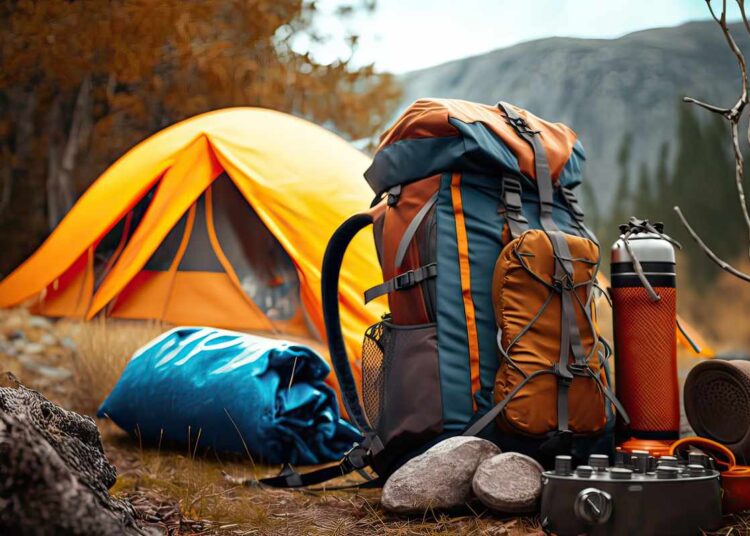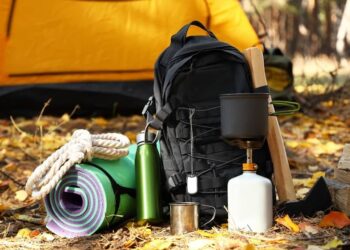The spirit of outdoor adventure has always pushed the boundaries of human endurance and ingenuity. Today, thanks to an explosion of new kit, the wilderness is more accessible, safer, and more enjoyable than ever before. This isn’t just about incremental improvements; it’s about revolutionary gear that’s fundamentally reshaping how we explore, interact with nature, and push our personal limits. From ultralight materials and intelligent navigation systems to self-sustaining power sources and advanced communication devices, these innovations are dismantling traditional barriers and unlocking unprecedented possibilities for adventurers of all stripes. This comprehensive exploration delves into the cutting-edge tools and technologies empowering modern outdoor enthusiasts, examining how this revolutionary kit is not merely enhancing existing capabilities but actively redefining safety protocols, personalizing experiences, and fostering a deeper connection with the natural world. We’ll unpack the intricate details of these powerful solutions, understanding their current impact, and their boundless potential to usher in an era of more intelligent, sustainable, and accessible outdoor pursuits.
Advanced Materials and Apparel

The very fabric of outdoor gear is undergoing a revolution, with new materials offering unprecedented combinations of lightness, durability, and protection against the elements.
A. Ultralight and High-Strength Fabrics: The relentless pursuit of minimal weight without sacrificing durability has led to breakthroughs in ultralight and high-strength fabrics. Materials like Dyneema Composite Fabric (DCF), originally used in sails and ballistic protection, are now found in tents, backpacks, and shelters. It’s incredibly strong for its weight, highly waterproof, and resistant to tears, enabling adventurers to carry less without compromising on protection. Similarly, advanced nylons and polyesters with enhanced ripstop weaves and silicone coatings offer superior strength-to-weight ratios for a wide range of gear, making it possible to go further, faster, and more comfortably.
B. Breathable and Waterproof Membranes: Staying dry and comfortable in challenging conditions is paramount, and breathable and waterproof membranes like Gore-Tex, eVent, and Polartec NeoShell continue to evolve. These revolutionary fabrics allow perspiration vapor to escape while completely blocking liquid water, preventing the clammy feeling associated with older rain gear. The latest iterations focus on improved breathability, softer hand feel, and enhanced durability against abrasion, providing optimal climate control for active pursuits in wet environments. This innovation ensures adventurers remain comfortable and focused, even when battling extreme weather.
C. Advanced Insulation Technologies: Battling cold requires cutting-edge insulation technologies. Beyond traditional down and synthetic fills, new materials offer superior warmth-to-weight ratios and better performance in damp conditions. Hydrophobic down, treated to resist moisture absorption, maintains its loft and warmth even when wet. Advanced synthetic insulations, mimicking down’s structure while retaining warmth when damp, continue to improve in compressibility and warmth. Emerging aerogels and phase-change materials are also being integrated into specialized apparel and sleeping systems, offering unprecedented thermal efficiency in minimal bulk, allowing adventurers to stay warm with less gear.
D. Adaptive and Smart Textiles: The future of outdoor apparel is moving towards adaptive and smart textiles. These fabrics can react to environmental conditions or the wearer’s body. Examples include materials that change their thermal properties based on temperature (e.g., cooling when hot, warming when cold), self-cleaning fabrics, or those with embedded sensors. While still emerging, these intelligent textiles promise to optimize performance and comfort dynamically, offering truly personalized climate control and health monitoring directly from your clothing, making gear an active participant in your adventure.
Navigation and Communication
Getting lost is a bygone era for well-equipped adventurers, thanks to revolutionary navigation and communication tools that offer unparalleled precision and global reach.
A. Advanced GPS Devices and Satellite Communicators: Beyond smartphone GPS, dedicated advanced GPS devices (like Garmin inReach or Montana series) offer ruggedness, extended battery life, and offline mapping capabilities essential for remote areas without cellular service. More critically, satellite communicators provide two-way messaging, GPS tracking, and SOS capabilities via global satellite networks (e.g., Iridium, Globalstar). This revolutionary kit allows adventurers to send messages to loved ones, share their location, and, most importantly, trigger an emergency rescue even when thousands of miles from the nearest cell tower, offering unparalleled safety and peace of mind in the backcountry.
B. Integrated Wearables with Navigation and Health Monitoring: Modern outdoor-specific smartwatches (e.g., Garmin Fenix, Suunto, Coros) are becoming powerful wrist-worn command centers. They integrate multi-band GPS for pinpoint accuracy, altimeters, barometers, and compasses for robust navigation. Beyond location, they offer comprehensive health monitoring: continuous heart rate, blood oxygen (SpO2), sleep tracking, and even hydration reminders. Some can send emergency alerts or connect to satellite communicators. These devices consolidate vital information and safety features, allowing adventurers to monitor their performance, navigate complex terrain, and maintain critical connectivity from their wrist.
C. Portable Satellite Internet Systems: For expeditions, remote research, or digital nomads seeking full connectivity in the wilderness, portable satellite internet systems are emerging as game-changers. Compact terminals connecting to Low Earth Orbit (LEO) satellite constellations (like Starlink) can provide high-speed internet access in virtually any remote location. This revolutionary kit enables real-time communication, data uploads (for scientific research or content creation), and access to online resources far from traditional infrastructure, blurring the lines between wilderness exploration and digital connectivity.
D. Mesh Network Communication Devices: For group communication in areas without cellular service, mesh network communication devices (like goTenna Mesh) create local, off-grid communication networks. These small, portable devices connect to each other, forming a mesh that extends communication range by relaying messages between units. They allow groups to send text messages, share locations, and maintain communication even deep in the wilderness, without reliance on satellites or cell towers, offering a robust and self-healing communication solution for dispersed teams.
Portable Power and Energy Solutions

The ability to generate and store power on the go is liberating adventurers from the constraints of battery life, enabling longer trips and more sophisticated equipment usage.
A. High-Capacity Portable Power Stations and Power Banks: The evolution of high-capacity portable power stations has revolutionized off-grid living and extended adventures. These large battery packs (often LiFePO4 for durability and safety) feature multiple output ports, including AC outlets, USB, and DC, allowing users to power laptops, mini-fridges, drones, and even medical equipment. Paired with foldable solar panels, they create self-sufficient power hubs. For smaller needs, compact yet powerful power banks (often 20,000mAh+) can recharge smartphones, headlamps, and GPS devices multiple times, ensuring essential electronics stay powered throughout any trip.
B. Portable Solar Chargers and Flexible Panels: The efficiency and portability of portable solar chargers continue to improve. Foldable and rollable solar panels, often made with flexible monocrystalline cells, can be easily attached to backpacks or tents to continuously charge power banks or directly power devices. Advances in solar cell technology allow for more power generation in smaller, lighter footprints, making solar energy a practical and reliable renewable power source for adventurers, reducing reliance on external charging infrastructure and enabling true self-sufficiency in sunny environments.
C. Micro Hydroelectric and Wind Generators: For stationary camps or long-term remote operations where there’s access to flowing water or consistent wind, micro hydroelectric and portable wind generators offer sustainable, continuous power generation. Compact designs make them transportable, allowing adventurers to harness natural energy sources to keep their larger power stations charged or directly power more demanding equipment. While more niche, these solutions offer robust, eco-friendly energy independence for base camps or longer expeditions, moving beyond reliance on solar alone.
D. Thermoelectric and Kinetic Energy Harvesters: Beyond direct solar or wind, thermoelectric generators (TEGs) can harness waste heat from campfires or cooking stoves to charge small electronics. More broadly, kinetic energy harvesters convert movement (walking, pedaling) into electricity, offering supplemental charging for small devices like headlamps or GPS watches. While generating smaller amounts of power, these ingenious solutions contribute to overall energy self-sufficiency by utilizing readily available ambient energy sources, ensuring critical devices remain functional in remote settings.
Tools for Exploration and Survival
Modern outdoor gear extends to specialized tools that enhance performance, safety, and comfort in various adventurous pursuits.
A. Advanced Water Filtration and Purification Systems: Access to clean drinking water is paramount for survival. Advanced water filtration and purification systems have become lighter, faster, and more effective. Portable filters with hollow fiber membranes remove bacteria and protozoa, while purifiers using UV light or chemical treatments neutralize viruses. Hand pumps, gravity filters, and integrated bottle filters offer versatile solutions, allowing adventurers to safely drink from natural sources, significantly reducing the weight of carried water and enhancing safety in the backcountry.
B. Compact and Multifunctional Tools: The essence of efficient kit lies in multifunctionality. Compact and multifunctional tools integrate several useful features into a single, lightweight package. This includes advanced multi-tools with pliers, knives, saws, and screwdrivers. Innovations also extend to specialized cooking systems (e.g., integrated stove/pot setups that boil water rapidly with minimal fuel), first-aid kits packed with advanced trauma supplies, and emergency shelters that convert into bivvy bags or groundsheets, ensuring adventurers are prepared for various scenarios without carrying excessive weight.
C. Intelligent Lighting and Headlamps: Modern outdoor lighting provides superior illumination with greater efficiency and adaptability. Intelligent headlamps feature multiple beam patterns (spot, flood), varying brightness levels, and red light modes for night vision preservation. Rechargeable batteries (often USB-C) and power-saving modes extend runtimes. Some headlamps integrate light sensors to automatically adjust brightness, while others offer reactive lighting that adapts to immediate surroundings, providing optimal visibility and extending battery life during nighttime navigation or camp tasks.
D. Portable Cooking Systems and Food Preservation: Outdoor cooking has been revolutionized by portable cooking systems. Ultralight canister stoves, efficient liquid fuel stoves, and even wood-burning gasifier stoves offer fast and reliable cooking in the backcountry. Innovations in food preservation include lightweight freeze-dried meals that rehydrate quickly and compact dehydrators for preparing custom lightweight provisions. This kit allows adventurers to prepare nutritious and varied meals on the trail, enhancing comfort and morale on extended trips without excessive weight.
E. Personal Locator Beacons (PLBs) and Satellite Messengers: While mentioned under communication, Personal Locator Beacons (PLBs) and satellite messengers are crucial standalone survival tools. PLBs transmit a distress signal to search and rescue authorities via satellite, providing your precise location globally with dedicated 406 MHz channels. Satellite messengers offer two-way text messaging with rescue services and loved ones, location sharing, and SOS functions. This is arguably the most critical piece of new kit for backcountry safety, offering a lifeline in true emergencies.
Accessibility, Sustainability, and New Frontiers
The evolution of new outdoor kit has profound implications beyond individual adventures, impacting accessibility, environmental stewardship, and the very future of exploration.
A. Democratization of Outdoor Activities: The advancements in lightweight, durable, and user-friendly gear have significantly contributed to the democratization of outdoor activities. What once required specialized training and expensive, heavy equipment is now more accessible to a wider range of people, regardless of age, physical ability (e.g., adaptive outdoor gear), or experience level. This encourages more people to connect with nature, fostering appreciation and stewardship for wild places.
B. Sustainable Gear Production and Practices: As awareness of environmental impact grows, the outdoor industry is focusing on sustainable gear production and practices. This includes using recycled and responsibly sourced materials (e.g., recycled polyester, bluesign® approved fabrics), reducing chemical usage in manufacturing, developing PFC-free durable water repellent (DWR) coatings, and designing gear for longevity and repairability. The emphasis is shifting towards a circular economy where products are made to last and materials are recovered at the end of their life, minimizing the ecological footprint of our adventures.
C. Data-Driven Performance and Safety: The integration of sensors and AI into outdoor gear is leading to data-driven performance and safety. Wearables provide continuous biometric data, mapping tools offer real-time elevation and weather overlays, and even smart tents could monitor environmental conditions. This wealth of data allows adventurers to optimize their performance, make safer decisions based on objective information, and contribute to scientific research on human physiology in extreme environments.
D. Adaptive Gear and Inclusivity: New kit is being specifically designed to enhance inclusivity in outdoor adventures. This includes adaptive gear for individuals with disabilities, such as specialized wheelchairs for rugged terrain, prosthetic attachments for climbing or cycling, and adaptive kayaks. These innovations are opening up the wilderness to a broader community, ensuring that the transformative experiences of outdoor exploration are available to everyone, regardless of physical challenges.
E. Long-Term Wilderness Monitoring and Conservation: The same advanced sensors and communication gear used by adventurers can also be deployed for long-term wilderness monitoring and conservation. Remote cameras, environmental sensors, and satellite trackers can monitor wildlife populations, track climate change impacts, detect illegal poaching or logging, and assess ecosystem health in remote areas. This data is crucial for scientific research and informs conservation strategies, making adventurers unwitting allies in protecting the very wild places they explore.
Conclusion
The new kit emerging for outdoor adventures is far more than just equipment; it’s a testament to human ingenuity and our enduring drive to explore. From hyper-efficient materials and reliable navigation systems to self-sustaining power sources and intelligent apparel, these innovations are dismantling old limitations and creating a safer, more sustainable, and profoundly richer experience of the natural world. While navigating the complex ethical considerations of wilderness impact and equitable access will be an ongoing journey, the boundless potential for personal growth, environmental stewardship, and the exploration of new frontiers ushered in by this cutting-edge gear promises a vibrant and ever-evolving future for outdoor pursuits. The wild is calling, and with this new kit, we are more prepared than ever to answer.








